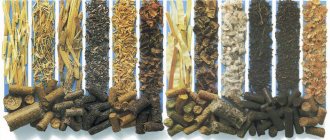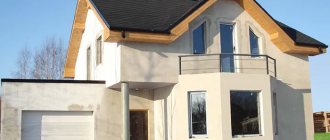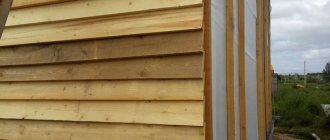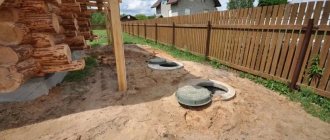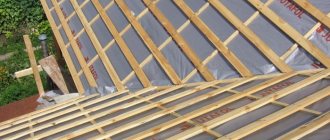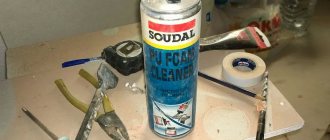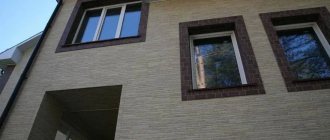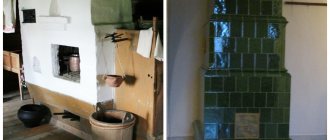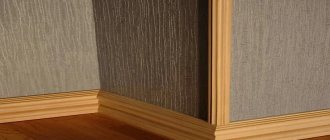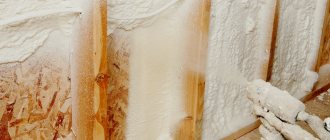Materials used in the construction of roofs and arrangement of premises with non-standard temperature and humidity operating conditions are endowed by manufacturers with special properties. They not only easily resist the attacks of steam-saturated hot air, but also create a “thermos” effect, due to which energy consumption for heating is greatly reduced.
These specific products include foil vapor barrier, the installation of which allows you to solve a lot of important problems in the construction of building structures.
Principle of operation
Foil materials are a complex product with a layered structure. The base here is polypropylene fabric, fiberglass, and lavsan. These are components that are resistant to explosive effects, biological and chemical aggression.
The use of a durable non-woven or woven polymer base allows you to create a reliable base for metal foil, which itself cannot boast of particular strength. At the same time, flexibility convenient for installation is maintained. This composition eliminates the possibility of fungal colonies settling and rotting.
Vapor barrier materials on the working side are backed with metallized film. The positive qualities of both aluminum foil and the polymer base are preserved. Vapor barrier with foil copes with three tasks at once:
- Insulation from precipitation and steam. The foil material protects the wall insulation system or roofing pie from steam penetration.
- Reflection of thermal radiation. The metal coating serves as a kind of reflector; it interrupts the flow of heat waves, redirecting the stopped heat within the house.
- Protection from ultraviolet rays and wind. Vapor barrier films are a durable barrier against wind. In the summer, they are able to reflect the sun's rays from the roof if they are installed with the working side facing outwards.
Additional solution for the attic: “Ondutis R Termo”
This material is used for thermal insulation of metal and wooden structures. When insulating an attic space or installing a roof in a residential attic, the film allows you to retain heat and reduce heating costs.
The water resistance of this vapor barrier is 1000 mm of water column; as for the minimum vapor permeability, this parameter is less than 10 g/m2 per day. The material easily endures temperature changes ranging from -40 to +120 °C. When considering strength, you should pay attention to the breaking load, which is 150 N along and 130 N across. This indicates that this foil film can support the weight of an adult.
Methods of application
The structure of foil vapor barrier materials has significantly expanded the scope of application. Now they are actively used in insulated roofs , they are often placed on the inside of the roof pie, and in the south they are usually mounted above the insulation. If the house has an unfurnished attic, then foil protection is installed along with waterproofing.
They are often used as a substrate for floor coverings and underfloor heating systems, and for insulating frame wall structures. A foil vapor barrier is also installed in the form of a screen that reflects heat flows from any heating units.
The system must be installed correctly so that the foil materials can perform their reflex function. Between the ceiling of the steam room, the walls, the inner lining of the attic and the metal covering, you should always leave a non-ventilated air gap, the thickness of which should not be less than 2 cm.
If the material is used as a heat-reflecting screen for an attic or flat roof, then a ventilated gap of 3 cm is left . Here, everything that is reflected from the foil can easily be discharged onto the street along with the penetrated steam and condensate.
The necessary gaps are formed by installing a sheathing made of a metal profile or bar. The laths are installed taking into account the type of roofing, the calculated load on the structure, and the slope of the slopes is also taken into account.
Waterproofing and vapor barrier: what is the difference?
The main difference between waterproofing and vapor barrier is the vapor permeability of materials. Waterproofing does not allow moisture to pass through, but collects it on the surface. Therefore, this type of material is laid in those places where moisture enters in the form of drops, for example, under corrugated sheeting on the roof. Condensation from the corrugated sheeting in the form of drops of water falls on the waterproofing, flows down it and is discharged outside the roof (that’s why the edges of the waterproofing are wrapped in the form of an envelope).
The task of vapor barrier is different: it should prevent water vapor from penetrating into the insulation. Since the vapors are mostly on the warmer side, membranes or films are often laid on the “warm” side. If we talk about the roof, then vapor barrier materials are placed from the attic side; if we talk about the vapor barrier of the walls of the steam room or other rooms of the bathhouse, then membranes/films are placed behind the decorative cladding.
To summarize: waterproofing does not conduct water (but can conduct steam, releasing the one that has penetrated into the insulation); vapor barrier does not allow steam to pass through.
The difference between vapor barrier and waterproofing is described in detail in the video.
It must be recalled that the dew point, in relation to the premises of a bathhouse or sauna, is often floating.
Benefits of use
Insulating materials, where water-repellent material is combined with foil, have many advantages, which is why they are in high demand among craftsmen. These include:
- Minimum thickness. Laying does not affect the thickness of the roof pie. If materials with anti-condensation properties are used, then it is not necessary to install a distance gap.
- Lightness. This installation will not affect the weight of the structure. Therefore, there will be no need to carry out additional actions to strengthen the foundation.
- Flexibility. Installation is easy, even if you have to lay the material on complex forms. You can easily go around concave and convex corners, various rounded surfaces.
- Environmental Safety. Vapor barrier films are made from materials that are not harmful to human health or the environment.
- Manufacturability. The sheets are easy to cut with regular scissors, or you can use a construction knife.
- Zero porosity. Vapor barrier does not absorb moisture. Long-term use, even in a damp room, will not cause the foil to rot.
- Multifunctionality. The same film can be used to protect several adjacent structures, creating a continuous sealed barrier.
How to lay and why
Typically, a vapor barrier is installed on the side of the room. This is due to the fact that indoor humidity is usually higher. This is especially true for kitchens, bathrooms, as well as baths and saunas. For baths or saunas built from wood, the penetration of moisture into the wood is also fraught with the formation of mold and the gradual destruction of the wood. This problem is especially relevant for Russian baths with their high level of humidity.
Vapor barrier prevents steam from penetrating to the heat insulator
In traditional bathhouses made of rounded logs without additional thermal insulation, the removal of vapors, regulation of humidity and drying of the room occurs due to natural processes. Even with perfectly fitted logs and caulked inter-crown joints, the removal of vapors and the supply of fresh air occurs due to the micropores of the wood, small cracks in the logs. This is exactly how our ancestors steamed: they warmed up the bathhouse for a long time - six to eight hours, did not rush anywhere and did not save wood.
We need the bathhouse to be ready within an hour maximum, while energy costs should be minimal. This is achieved through a multi-layer “pie” made of various materials to retain heat and steam. A vapor barrier layer in such a “sandwich” is required, otherwise all the “layers” will have to be changed in a year or two, and the wood will have to be “treated” for a long time and persistently from mold and fungi.
Installation technology
Most often, vapor barrier materials with foil are used to equip a cold attic and a warm attic. In the first case, the insulation system must be installed along the ceiling, in the second - along the slopes.
To install a vapor barrier correctly , you need to adhere to generally accepted construction rules:
- The vapor barrier of the slopes should be a continuous barrier that prevents the penetration of moisture. To do this, the canvases need to be sealed together with regular tape.
- Strips of vapor barrier material are usually laid strictly horizontally. The first panel is fixed at the ridge girder, the second is placed on top to cover the edge of the installed panel on the side of the room that is being finished.
- The canvas spreads from the attic side onto the wooden floor in strips, extending onto the walls along with vertical ceilings of 20 cm each. It turns out to be a kind of pallet with sides.
- Then the material is rolled out as if the roll was formed by the manufacturer himself. The installation side is indicated on the vapor barrier - it cannot be changed at your discretion.
- On pitched roofs, the material is stapled to the rafters from the inside. If they are fixed with a block, then a counter-lattice must be placed on top under further cladding.
- If you need to put a vapor barrier in a system with open rafters, then it is placed along the outer ribs, then rigid slab insulation is installed. The fabric is secured with a stapler.
- If you are installing a ceiling on the ceiling side, then you need to buy self-adhesive materials.
It is worth noting that accessories for foil insulation must be selected from the same manufacturer as the material. Of course, you can find universal tape on sale that is suitable for joining materials of any kind, but in the case of foil structures, you need to remember about tightness. Therefore, here it is better not to experiment with options for adhesive tape for gluing, but to take it from the same company that produces the foil sheets themselves.
How to attach a vapor barrier
The choice of fastening method depends on the type of vapor barrier material used. Polyethylene and polypropylene films are secured with small nails or with staples and a construction stapler.
Construction stapler (mechanical)
In order to minimize damage, it is advisable to use wooden planks that press the film against the guides, and drive staples/nails into the plank. Membranes can be attached in the same way. They are not as torn as films made of polyethylene or polypropylene, and they are easier to work with.
Attaching the vapor barrier
The sheets of rolled materials are laid one on top of the other with an overlap of at least 10-15 cm, gluing the joints with adhesive tape. You can use specialized, foil or regular adhesive tape.
Double-sided adhesive tape UNIBOB based on cotton fabric. An adhesive layer based on synthetic rubber, which ensures high quality gluing of vapor-waterproofing sheets
Foil tape must be used at the joints of foil materials, otherwise most of their effectiveness is lost. When gluing joints of other materials, manufacturers recommend using their own adhesive tape, but they do not explain their differences and advantages.
Please note that during installation the vapor barrier sheets should not be stretched: they tend to stretch/shrink when temperatures change. To avoid ruptures during tension, you need to leave a small margin. It is considered normal for the canvas to “sag” by 1-2 cm during installation. This is especially true when laying a vapor barrier on a roof or in an unheated room.
When installing vapor barriers in places with complex terrain (protrusions, corners, etc.), it is advisable to seal the adjacent surfaces with tape: perfect tightness in such places is difficult to achieve, and this is the main condition for the effectiveness of protection. Therefore, any aids will be useful. It is also necessary to tape the edges of the vapor barrier around the perimeter of door and window openings to ensure a tight seal. In general, tightness is the basis for high-quality vapor barrier of a bathhouse, roof or any other room. Therefore, when carrying out work, pay maximum attention to this aspect.
Leading foil products
To install a ceiling or attic, you need to select a suitable and reliable vapor barrier film. Therefore, you should first find out what proven and popular product options are available on the construction markets.
Energy saving film DELTA®-REFLEX
These products have proven themselves well in roof construction and have an impeccable reputation among roofers. The reflective coating on the working side is created by spraying. Then a polyester film is applied over it, which protects the aluminum layer from shedding and damage. The reflection coefficient of this product is about 50%.
At sub-zero temperatures , the film does not lose its flexibility; it is used to provide protection against steam from inside and outside the house. Can be used in different rooms with high humidity. If you find a version of a similar film, but where the word PLUS is added to the marking, then there will be a self-adhesive tape along the edge of such films - it makes the work of installers much easier, which is why it is what is most often purchased, despite the high cost of the product.
Reflective material “Izospan FD”
In terms of price, this is a more humane option, but it is also less resistant to the realities of adversity. This is a two-layer composition made of polypropylene fabric, with an aluminum coating applied on top.
In terms of strength indicators, it is inferior to the first option, but is able to outperform in terms of energy-saving characteristics: the coefficient of thermal reflection is about 90% . It usually attracts installers with its affordable price; in addition, these products are easy to find in many hardware stores. It is worth noting that in the technical data sheet of the film, a separate line indicates the temperature range, which ranges from -60 to +80 degrees.
"ARMOFOL® type A" super durable
This vapor barrier is made on the basis of a durable fiberglass mesh. The scope of application is exactly the same as the two previous options. But the operating temperature range is more extended. The material works flawlessly at temperatures of -60 degrees (Delta has a threshold of -40). And in the plus segment the limit reaches +150 degrees.
Armofol is used both in new construction and for restoration work during the repair of basement and basement structures, roofs, swimming pools, saunas, bathrooms, steam Russian baths. In terms of thermal reflection, the coefficient reaches 97%; due to this indicator, the material is also purchased very often.
Information about the use of foil vapor barrier film for construction is needed by both professional roofers and independent craftsmen. Properly installed material guarantees that your favorite property will be equipped for a long period of use. Therefore, such repair work must be approached with full responsibility: starting from the selection of popular options for foil films and ending with their installation.
The main disadvantages of Penofol
Some consumers refuse to purchase Penofol when they learn about its shortcomings. Among them:
- high penetration;
- inconvenience during installation due to the need to use special adhesives;
- Insulating walls from the outside with Penofol involves using the material only as an additional layer of thermal insulation.
As for high penetration, it will manifest itself even at low pressure; this characteristic is due to the softness of the material.
Which side should you put the insulation with foil on?
We'll tell you how to properly lay foil insulation. Since its production technology requires two layers, you need to understand which side is best to lay it on. The universal material should be laid so that the foil is on the outside. Thanks to the metal, all the benefits of insulation appear on a shiny surface, otherwise the heat will not linger inside.
It must be remembered that during the work it is necessary to leave an air gap between the insulation and the finishing, and do not attach the finishing material too tightly to the foil.
To insulate a room from the inside, it is enough to follow simple rules and act in stages.
Step by step guide:
- If the sheets have an adhesive layer applied, it is easier to glue them directly to the wall.
- A method of attaching rolled insulation without special glue is using a stapler.
- If the slab is attached, we make lathing. The slats are stuffed to create a layer of air.
- Then we attach the insulator to the cells, then secure it using dowels.
- Construction tape will help seal cracks in the wall.
- The insulation must be laid closely, eliminating every gap.
- Self-adhesive polyethylene foam is secured additionally.
Rules for installing insulation for external walls
Let's move on to how to properly lay penofol on the outside walls of a house. Any construction forum will show many different photos and tips on this topic.
Penofol is the most popular material for do-it-yourself home insulation. Its technical merits were appreciated by everyone who lives in Moscow and other cities. After making a comparison, you will understand that this is the best thermal insulator. Thermal insulation isolon is used in a wide variety of areas, and everyone can get a warm home.
From the outside, 2-3 layers of thermal insulation must be attached to the concrete wall - expanded polystyrene, mineral wool or self-adhesive penofol, since good sound insulation should be obtained. If the insulation is not covered with glue, you need to select and buy glue in advance.
- Once you've chosen the polystyrene foam, clean the wall and prime the area. It is better to use starting strips for this - this allows you to do the correct pasting.
- We glue the insulation to the concrete (the use of special solutions is important here). Use the solution only according to the instructions.
- Press the insulation firmly against the frame or base of the wall.
- We make joints in the corners.
If you plan to lay mineral wool insulation:
- The first stage is laying mineral wool on the facade.
- We fasten with self-tapping screws or using wide fasteners.
- We lay two layers of insulation end to end.
- We fix it with a protective film.
Insulation of the under-roof space
When insulating your home, you should not skimp on quality materials. Izolon (penofol) has important advantages. There are drawbacks, or rather, there is only one – the price is not too low.
This type of thermal insulation is an excellent material and is a good option for protecting your home from the cold. The main thing is to remember that the house needs to be insulated on both sides: internal and external.
How to attach penofol to the wall of the attic floor? There are no big differences in insulation technology, the principle is approximately the same. The main thing is to take care of quality.
Having arranged the under-roof space correctly, you will be sure that:
- Heat loss will be minimal.
- No moisture will get inside.
- Vapors will be released outside.
The roofing pie, consisting of seven layers, copes with its tasks perfectly. It includes interior finishing, followed by layers of vapor barrier, thermal insulation, and waterproofing. A separate space is also allocated for ventilation. Then they install a counter-lattice, a grate and “cover” the pie with a roofing covering.
Each layer is needed to perform specific functions, and none of them can be skipped or installed incorrectly.
Using foil insulation, you will make the under-roof space warm and cozy. It works great at protecting your home from the cold.
How to attach insulation to a basement floor inside a house
The leader in choice of thermal insulation for internal basement floors is penofol. It retains warm air well indoors and has its advantages:
- Environmentally friendly
- Not flammable
- Has good vapor permeability
- With a high level of sound insulation.
Any construction reference book will show that the thickness of thermal insulation should be within 15 cm, and in areas with cold winters - up to 20 cm. But the final calculation, of course, will depend on sanitary standards and regulations.
The base is the upper part of the foundation, which rises about half a meter from the ground. This structure also serves as a support for the ceiling of the first floor.
Horizontal waterproofing is installed on the ground floor. It prevents moisture from entering the basement floor. Expanded polystyrene is usually used to insulate basement structures. It repels water well and retains heat.
Beginners often ask the question of how to glue penofol and expanded polystyrene to the basement floor inside the house. Choose glue or mastic without a solvent; hot bitumen mastic will not work either.
Dew point problem
Ideally, the roof in the attic should be insulated from the outside at the stage of forming the roofing pie. However, often this is done the other way around from the inside, when the house is already covered with a roof. And here certain problems arise.
The correct and ideal roofing pie is several layers of different materials laid on top of the rafters tightly on top of each other without gaps. Such a sandwich ensures that the dew point will be located on its outer side. As a result, all condensate formed outside will quickly evaporate into the atmosphere.
By doing insulation from the inside, after installing the roof, it is impossible to form the exemplary roofing pie described above. It will not be possible to press the insulation onto the roof so that there are no voids left between them.
But steam always moves towards cold air. And then, each of the formed cavities will begin to accumulate condensation and moisture. And this is a direct path to damage to the thermal insulation material and wooden elements of the rafter system.
When insulating an attic internally, the dew point has to be shifted into the space between the laid roof and the insulation, leaving an additional 5–10 cm gap there for ventilation. Only such a technology and such a cake will avoid moisture in the insulating material.
To reduce the amount of water vapor in the insulation, its installation should be done using a vapor barrier film. A vapor barrier is installed from the inside of the attic on top of the thermal insulation material.
The steam must first encounter this film and mostly remain in the room. The less of it gets into the insulation layer, the better.
Varieties of "Penofol"
"Penofol" can be classified by type:
- A.
- IN.
- WITH.
- ALP.
- R and M.
- Super NET.
- AIR.
In the first type, the aluminum layer is applied only from the outside; this material is used in conjunction with polystyrene foam and styrodur. Type B is coated on both sides and is suitable for independent use. Type C is a self-adhesive material in which the outside is covered with foil, while the inside is polyethylene foam with contact adhesive.
ALP is “Penofol”, on top of the aluminum layer of which a polyethylene film is fixed. This material is laminated and can be used for needs in rural areas. One-sided foil embossed material are varieties R and M. But “Super NET” is used for thermal insulation of networks. The latter variety is suitable for air ducts.

